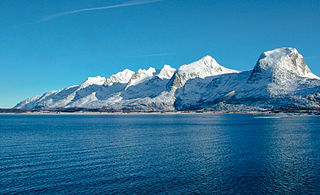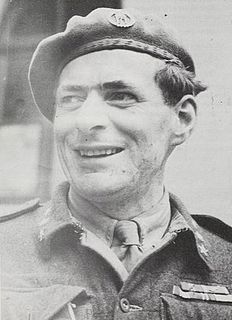Lark was the code word for the group that was sent from the United Kingdom to Trondheim, Norway as part of the preparations for a possible Allied invasion of Norway. Lark developed into the main organisation for the Special Operations Executive (SOE) in Trøndelag, and became the effective leadership of Milorg in the region. [1]

The United Kingdom (UK), officially the United Kingdom of Great Britain and Northern Ireland, and sometimes referred to as Britain, is a sovereign country located off the north-western coast of the European mainland. The United Kingdom includes the island of Great Britain, the north-eastern part of the island of Ireland, and many smaller islands. Northern Ireland is the only part of the United Kingdom that shares a land border with another sovereign state, the Republic of Ireland. Apart from this land border, the United Kingdom is surrounded by the Atlantic Ocean, with the North Sea to the east, the English Channel to the south and the Celtic Sea to the south-west, giving it the 12th-longest coastline in the world. The Irish Sea lies between Great Britain and Ireland. With an area of 242,500 square kilometres (93,600 sq mi), the United Kingdom is the 78th-largest sovereign state in the world. It is also the 22nd-most populous country, with an estimated 66.0 million inhabitants in 2017.

Trondheim is a city and municipality in Trøndelag county, Norway. It has a population of 193,501, and is the third-most populous municipality in Norway, although the fourth largest urban area. Trondheim lies on the south shore of Trondheim Fjord at the mouth of the River Nidelva. The city is dominated by the Norwegian University of Science and Technology (NTNU), the Foundation for Scientific and Industrial Research (SINTEF), St. Olavs University Hospital and other technology-oriented institutions.

Norway, officially the Kingdom of Norway, is a Nordic country in Northern Europe whose territory comprises the western and northernmost portion of the Scandinavian Peninsula; the remote island of Jan Mayen and the archipelago of Svalbard are also part of the Kingdom of Norway. The Antarctic Peter I Island and the sub-Antarctic Bouvet Island are dependent territories and thus not considered part of the kingdom. Norway also lays claim to a section of Antarctica known as Queen Maud Land.
Contents
The plan for a possible Allied invasion in Norway was to split Norway in half around Nord-Trøndelag and southern Nordland, and thus isolate the German troops in the north (Operation Jupiter). [2] Lark started its operations in Trøndelag on 10 February 1942, when Odd Sørli [ no ] and Arthur Pevik came to Trondheim from the UK. The group's mission was to start training men in weapons and guerrilla tactics. [3] Lark had been reinforced by Evald Hansen , Herluf Nygaard, Olav Krause Sættem and Arne Christiansen [ no ] by April 1942, while Pevik went to London where he wrote an extensive report to Major Malcolm Munthe. Sættem, Christiansen, Hansen and Sørli went to Stockholm later the same year. During this time, Lark was mainly occupied with a plan to sink the German battleship Tirpitz , which at the time was situated in the Trondheimsfjord. [4] Nygaard and Hansen were captured and tortured in December 1942; Nygaard later escaped, while Hansen died at Falstad. [5]

Nord-Trøndelag was a county constituting the northern part of the present-day Trøndelag county in Norway. The county was established in 1804 when the old Trondhjems amt was divided into two: Nordre Trondhjems amt and Søndre Trondhjems amt. In 2016, the two county councils voted to merge (back) into a single county on 1 January 2018.

Nordland is a county in Norway in the Northern Norway region, bordering Troms in the north, Trøndelag in the south, Norrbotten County in Sweden to the east, Västerbotten County to the southeast, and the Atlantic Ocean to the west. The county was formerly known as Nordlandene amt. The county administration is in Bodø. The remote Arctic island of Jan Mayen has been administered from Nordland since 1995.
Herluf Nygaard was a Norwegian military officer. He was born in Lurøy. He graduated from the Norwegian Military Academy in 1946. He was promoted to Colonel in 1965, and Major General in 1968. He served as General Inspector for the Home Guard from 1967. He was decorated Commander of the Order of St. Olav in 1971.
Lark was reinforced by Erik Gjems-Onstad, Johnny Pevik and Nils Uhlin Hansen in March 1943. [6] With the Allied invasion of Sicily in July 1943, it became clear that Norway would not be the scene of at least the primary Allied invasion of Europe. [7] Lark continued to organise Milorg-groups, and planned offensives against Nazi collaborators. [8]

Erik-Ørn Gjems-Onstad, MBE was a Norwegian resistance member, officer, lawyer, sports official, politician, author and anti-immigration activist.
Nils Uhlin Hansen was a Norwegian long jumper and resistance member during World War II. He had a successful athletics career before the war; holding the Nordic record in the event. He was killed less than four months before the end of the war, as he was surprised by Wehrmacht forces following a sabotage mission.

The Allied invasion of Sicily, codenamed Operation Husky, was a major campaign of World War II, in which the Allies took the island of Sicily from the Axis powers. It began with a large amphibious and airborne operation, followed by a six-week land campaign, and initiated the Italian Campaign.











